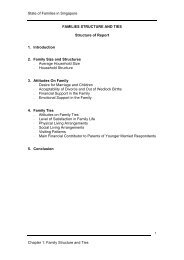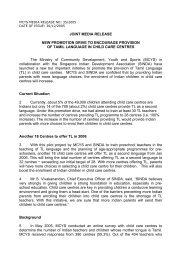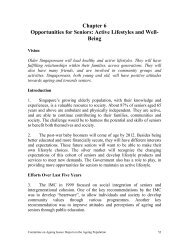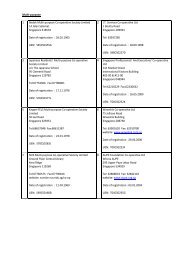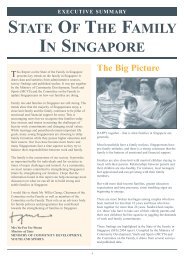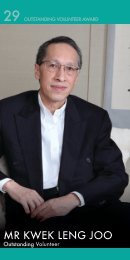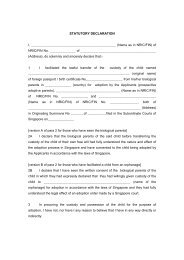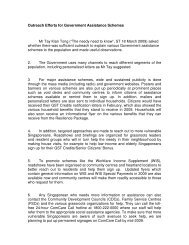General Assembly WOM/1875 - Ministry of Social and Family ...
General Assembly WOM/1875 - Ministry of Social and Family ...
General Assembly WOM/1875 - Ministry of Social and Family ...
You also want an ePaper? Increase the reach of your titles
YUMPU automatically turns print PDFs into web optimized ePapers that Google loves.
Introduction <strong>of</strong> ReportMs. BINTE YACOB said gender equality was central to the continued rapidsocio-economic progress in Singapore. “With people as our only natural resource, itfollows that investing in, developing <strong>and</strong> maximizing the full potential <strong>of</strong> every individual,male or female, is a priority.” Implementation <strong>of</strong> the Convention on the Elimination <strong>of</strong> AllForms <strong>of</strong> Discrimination against Women was an ongoing process that requiredownership by all stakeholders. Besides Government agencies, businesses, unions <strong>and</strong>employers, her <strong>Ministry</strong> worked closely with civil society, representatives <strong>of</strong> which werepresent today. She was pleased to announce that, last year, the country had ratified theamendment to article 20, paragraph 1 <strong>of</strong> the Convention.Singapore, she explained, was a parliamentary republic with a writtenConstitution, which guaranteed the principles <strong>of</strong> equality <strong>and</strong> non-discrimination. Theobligations <strong>of</strong> the women’s Convention were also realized through acts <strong>of</strong> Parliament,subsidiary legislation, policies <strong>and</strong> programmes, all <strong>of</strong> which were reviewed regularly<strong>and</strong> provided avenues for individual women to pursue gender equality. What she calleda “whole-<strong>of</strong>-Government” approach was taken to advance such equality. A group <strong>of</strong>senior Government <strong>of</strong>ficials <strong>of</strong> all key agencies coordinated efforts related to theConvention, <strong>and</strong> that process was supported by the Office for Women’s Development inher <strong>Ministry</strong>, recently upgraded from what was known as “the Women’s Desk”.Aided by such governance <strong>and</strong> robust socio-economic development, women inSingapore had come a long way, she said. The country was ranked tenth out <strong>of</strong>138 countries on the United Nations Gender Inequality Index. In the World EconomicForum’s gender gap index, the country had risen almost 30 places in one year, from84 in 2009 to 56 in 2010. International organizations had also recognized the country’sexcellent health-care system, with a maternal mortality rate among the lowest in the world, at2.6 per 100,000 births in 2010 <strong>and</strong> zero in 2009. Women had a literacy rate <strong>of</strong> 93.8 per cent,<strong>and</strong> female students made up more than half the full-time intake at local universities <strong>and</strong>were now well represented in traditionally male-dominated subjects. Stereotypes weredisappearing <strong>and</strong> women’s participation in the labour force had increased from below 30 percent in the 1970s to 56.5 per cent in 2010.Concerted efforts in helping people fulfil career aspirations, including grants to spurflexible working arrangements, had resulted in adoption by an increasing number <strong>of</strong>companies <strong>of</strong> work-life integration initiatives. Since the last report, means-tested subsidiesfor child care <strong>and</strong> kindergarten had been significantly enhanced. Significant enhancementshad been made to maternity benefits, <strong>and</strong> tax relief supported working mothers <strong>and</strong>caregivers. A national “dads for life” movement had been launched to encourage sharedcare-giving responsibilities. Enhanced paid child-care leave had resulted in many morefathers taking <strong>of</strong>f time for child care. Women made up 25.3 per cent <strong>of</strong> employers in 2010<strong>and</strong> constituted 56 per cent <strong>of</strong> the civil service, as well as 59 per cent <strong>of</strong> the top-twocategories <strong>of</strong> <strong>of</strong>ficers. Six <strong>of</strong> the 22 top civil service posts were occupied by women, <strong>and</strong>more than half <strong>of</strong> the judicial <strong>of</strong>ficers in the subordinate courts <strong>and</strong> just under 20 per cent <strong>of</strong>the Supreme Court were women.She said efforts were ongoing to overcome challenges for better work-life integration,to ensure that women’s skills remained up-to-date <strong>and</strong> to support elderly women in a rapidlyaging society. Measures were put in place to allow older people to work longer, to providebetter annuity opportunities, to maintain their health <strong>and</strong> to obtain financial maintenance fromtheir children.



